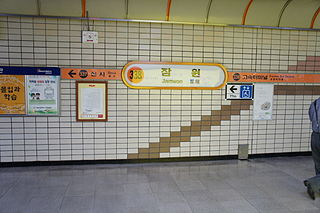
Jamwon Station is a station on the Seoul Subway Line 3. It is located in Jamwon-dong, Seocho-gu, Seoul.

Daechi Station (Korean: 대치역) is a station on the Seoul Subway Line 3. It is located in Daechi-dong, Gangnam-gu, Seoul. It was named after a former village in the area, Hanti (한티), as Daechi is the Chinese reading of the hanja. The name of the station is Chinese characters, meaning "big hill."

Maebong Station is a station on the Seoul Subway Line 3. It is located in Dogok-dong, Gangnam-gu, Seoul and was named after the nearby Maebongsan mountain.

Jamsilsaenae Station is a station on Seoul Subway Line 2, located in Jamsil-dong, Songpa-gu, Seoul. On December 15, 2016, it was decided to change the name Sincheon to Jamsilsaenae, to avoid confusion with Sinchon Station on the opposite end of the line. Saenae (새내) is the native Korean pronunciation of the Sino-Korean Sincheon (新川), meaning "new stream".

Sillim Station is a station on Seoul Subway Line 2 and the Sillim Line. It is located in Sillim-dong, Gwanak-gu, Seoul.
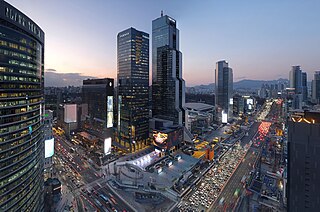
Gangnam District is one of the 25 districts of Seoul, South Korea. The term Gangnam translates to "South of the [Han] River". Gangnam District is the third largest district in Seoul, with an area of 39.5 km2 (15.3 sq mi). As of the 2017 census, Gangnam District had a population of 561,052. There is a high concentration of wealth in the district, with prices for an apartment as of 2020 nearly double those in the rest of Seoul. Gangnam District is part of Gangnam School District Eight, along with the Seocho District. This district shares half of Gangnam-daero Gangnam Station area with Seocho District, which is one of the most crowded places in South Korea.

Jamsil Baseball Stadium is a baseball stadium located at 25 Olympic-ro, Songpa-gu, Seoul, South Korea. The stadium holds 25,000 people and was built from April 1980 to July 1982. It makes up the Seoul Sports Complex along with the nearby Seoul Olympic Stadium, and hosted the baseball events during the 1988 Summer Olympics.

Jongno 3(sam)-ga Station is an underground station on lines 1, 3 and 5 of the Seoul Subway in South Korea.

Songpa-gu is a district of Seoul, South Korea. Previously known as Wiryeseong, the first capital of the kingdom of Baekje, Songpa is located in the southeastern part of Seoul. With roughly 647,000 residents, Songpa is also the largest district in Seoul by population.

Gangdong District (Gangdong-gu) is one of the 25 gu which makes up the city of Seoul. Gangdong, literally means "east of river".

Jamsil Station is an underground station on Line 2 and Line 8 of the Seoul Metropolitan Subway. Lotte World is continuous with the Line 2 station. The station is also called Songpa-gu Office Station (송파구청역), due to the proximity of the office building.

Express Bus Terminal Station is a station on the Seoul Subway Line 3, Line 7, and Line 9. The stations are located in the Greater Gangnam Area, Banpo-dong, Seocho District, Seoul, Korea.

Sincheon-dong or Sincheon is a neighbourhood (dong) in Songpa-gu, Seoul served by Jamsillaru Station on Seoul Subway Line 2. The name means "new stream" and is a name for several other places in South and North Korea.
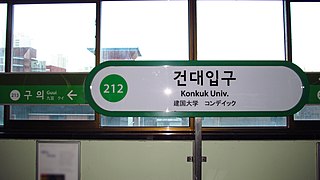
Konkuk University Station is a rapid transit station on Seoul Subway Line 2 and Seoul Subway Line 7. It is located in Hwayang-dong in the Gwangjin-gu administrative district of Seoul. It is adjacent to Konkuk University from which it takes its name. Line 2 is serviced by an elevated platform while Line 7 is serviced by an underground platform. The station has connections to ten bus lines through its six exits as well as a connection to the airport shuttle bus. The station services Hwayang-dong as well as Jayang-dong and Noyu-dong. The area around the station is mixed residential and small commercial businesses. Exits from the underground Line 7 platform open into Konkuk University and the adjacent Star City shopping and high-rise residential tower complex.

Seokchon Station is an interchange station on Line 8 and Line 9 of the Seoul Metropolitan Subway, located near Seokchon Lake Park. Originally a station along Line 8 only, it became a transfer station when an extension of Line 9 opened on 1 December 2018.

Songpa is a station on the Seoul Subway Line 8.
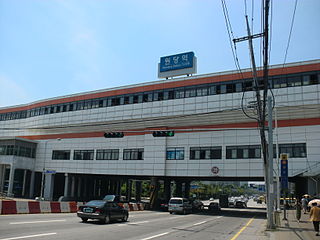
Wondang Station is on Seoul Subway Line 3 in Goyang, Gyeonggi-do. Goyang City Hall is nearby. There is a lot of building work in the area undertaken by SK, Daewoo and other companies; including many apartment complexes, shopping malls and a multiplex cinema.

Jamsil-dong is a neighbourhood, dong, of Songpa-gu, Seoul, South Korea. Its name is derived from silkworm breeding during the Joseon dynasty. Jamsil translates to a room or place for sericulture. The state encouraged people to raise silkworms, so founded Dongjamsil in the east vicinity of Seoul.
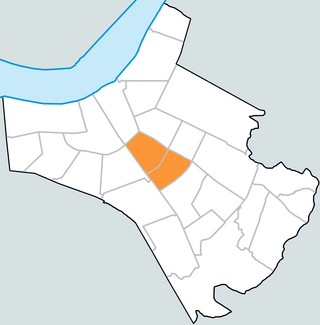
Songpa-dong is a neighbourhood, dong of Songpa-gu, Seoul, South Korea. There are three assumptions on the etymology of the name. One is that it may come from "Songpa Naruteo"

Seoul Sports Complex, a.k.a “Jamsil Sports Complex”, is a group of sports facilities in Songpa-gu in Seoul, South Korea. It was built for the 1986 Asian Games and 1988 Summer Olympics from December 1976 to September 1984. The complex is South Korea's largest integrated sports center, spanning an area of 402,816 m². The complex consists of the Olympic Stadium, Auxiliary Stadium, Jamsil Arena, Jamsil Baseball Stadium, Jamsil Indoor Swimming Pool, Jamsil Inline Skating Rink and the Sports Park.





















